
The Indian Power Industry is one of the largest and most important industries in India as it fulfils the energy requirements of various other industries. It is one of the most critical components of infrastructure that affects economic growth and the well-being of our nation.
India has the world’s 5th largest electricity generation capacity and it is the 6th largest energy consumer accounting for 3.4% of global energy consumption. Due to the fast-paced growth of the Indian economy, the country’s energy demand has grown at an average of 3.6% p.a. over the past 30 years.
In India, power is generated by State utilities, Central utilities and Private players. The share of installed capacity of power available with each of the three sectors can be seen in the pie-chart below:
As per the latest Report of CEA (Central Electricity Authority) i.e. as on 31-03-2011, the Total Installed Capacity of Power in India is 173626.40 MW. Of this, more than 75% of the installed capacity is with the public sector (state and central), the state sector having the largest share of 48%.
Working of the Power Industry: –
Thermal Power: – In India, major proportion of power is generated from thermal sources where the main raw material used is coal. Around 83% of thermal power is generated using coal as a raw material whereas 16% of thermal power is generated with the help of Gas and 1% of thermal power is generated with the help of Oil.
Hydro Power: – Hydroelectric power or hydroelectricity is electrical power which is generated through the energy of falling water. India has hydro power generation potential worth 1,50,000 MW, of which only 25 % has been harnessed till date.
Nuclear Power: – A Nuclear Power Plant is a thermal power station in which the heat source is one or more nuclear reactors. A nuclear reactor is a device to initiate and control a sustained nuclear chain reaction. In the process, heat is generated which is then used to generate electricity.
Renewable Energy Sources: – The energy obtained from renewable sources like sun, wind, biomass can be converted into power. Renewable energy sources have great potential to contribute to improving energy security of India and reducing green-house gas emissions. India is among the five largest wind power generators in the world.
What does the Past Say??…
How has the relationship between India’s economic growth and Power generation growth been?
As seen in the graph below, there is a positive correlation between the GDP Growth rate and the growth in Power Generation. As will be seen in the later part of this Shastra, India is currently facing acute shortage of power. The Indian growth story looks positive which will lead to higher economic growth and more demand for power. In order to sustain the growth in GDP, India needs to add power generation capacity commensurate with this pace.
Plant Load factor – A Measure of Efficiency: –
Plant Load Factor, a critical efficiency parameter in the power industry is a measure of the actual output of a power plant compared to the maximum output it can produce.
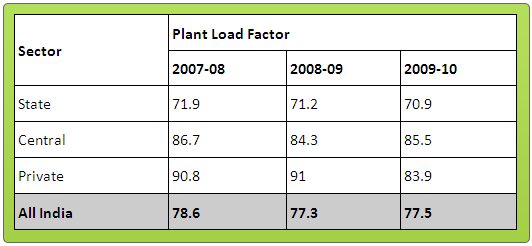
The State sector, that has the highest installed capacity is the least efficient. The private sector utilities have clocked good efficiency rates and the Central utilities have managed to achieve competent efficiency rates. Going forward, with private players being encouraged to enter the Power Sector, the state utilities will be required to work on improving their efficiency.
Performance of the top sector players in the past
Looking at the table below, it can be clearly observed that hydro-power producers like NHPC and SJVN operate at substantially higher profit margins than thermal power producers. This is because thermal power producers are required to spend a lot on Fuel (Coal, Gas, Oil).
Looking at the companies with a diversified portfolio of power, NTPC is the largest company (on Net Sales), but Tata Power has registered the highest growth rates in Sales and Net Profit. Among hydro power producers, NHPC’s performance has been very good, its Net Profit growing at a CAGR of 28%.
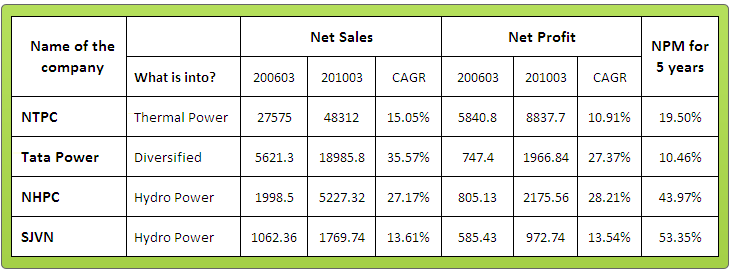
Porter’s 5 Forces analysis
What are the growth drivers of the industry?
1) Demand-Supply Gap: –
India has always been a power-deficient country. The demand for power is huge in India. As seen in the above graph, the supply of power in India has not been able to meet its demand. Under the Government’s “Power for all by 2012” plan, it has targeted per capita consumption of 1000 kWh by the end of the 11th Five Year Plan (2007-2012) as compared to levels of 734 kWh in 2008-09. In order to provide per capita availability of over 1000 kWh of electricity by year 2012, it is estimated that capacity addition of more than 1,00,000 MW would be required. This shows that huge capacity additions are required at good efficiency rates, indicating that the opportunities available in this sector are huge.
2) Government: –
The role of the Government in the development of Indian power industry has been very crucial. Government’s policies aim at protecting consumer interests and making the sector commercially viable. Government regulates this industry in various ways (Tariff control, Subsidies, environment norms, etc.) due to its linkages to various industries and to the growth of the economy.
– Regulatory role of Government: – As far as regulation is concerned, Electricity Act, 2003 is a very important Act as it allowed private sector participation in the generation of power, thus creating competition. It also allowed 100% FDI participation in the power generation, transmission and distribution, thus inducing investments in the power sector.
– Government Schemes: – The Government is investing in this industry through various development schemes: –
- The Rural Electrification Program is an effort to lighten up villages which have faced acute shortage of Power over the years.
- ‘Power for All by 2012’ plan aims at a per capita consumption of 1000kWh by the end of the 11th Five Year Plan (2007-12).
- The Accelerated Power Development and Reform Programme (APDRP) programme is being implemented so that the desired level of 15 per cent AT&C (Aggregate Technical and Commercial) loss can be achieved by the end of 11th plan (Currently it is 30%).
– Projects under pipeline: – The Government of India is planning nine Ultra Mega Power Projects (UMPP) of 4 GW each with an estimated individual investment of US$ 4 billion (Rs. 192 billion). Four of these projects are expected to be commissioned between 2011 and 2017. The UMPP is an initiative by the government to collaborate with power generation companies to set up 4,000 MW projects to ease the country’s power deficit situation.
3) Raw Materials: –
Thermal power segment, which has the largest capacity generation share in the Indian power industry, is dependent on inputs like coal, oil and gas for the generation of power. Coal shortages and the low thermal quality of coal supplies cause disruptions in power generation and result in lower plant load factors. When domestic supply of coal is insufficient, coal is imported. This is unfavourable for power companies as it leads to rise in costs.
With these problems associated with thermal power, the Power Companies enter in to Long Term Agreements (LTA) with coal suppliers or acquire coal mines to ensure regular supply of coal. Besides, currently coal players in India are adopting aggressive strategies by acquiring Coal mines outside India. Domestically, a good number of coal mines have received environmental clearances. Such actions will be beneficial for thermal power players.
Gas-based power plant face problems because of shortages in gas supply. The discoveries in the Krishna-Godavari Basin are expected to improve gas availability in India which is a big positive for India’s gas-based plants.
4) Transmission and Distribution: –
Transmission of electricity is defined as the bulk transfer of power over a long distance at a high voltage. Transmission and Distribution is as important as generation. The capacity additions to meet India’s growing power demand should be supplemented by adequate transmission infrastructure. Globally, every dollar invested in generation has an equal amount invested in transmission and distribution. However, in India traditionally every dollar invested in generation has a corresponding half a dollar invested in transmission and distribution. Due to this, transmission capacity in India lags behind the generation capacity. Huge investments are required in Transmission and Distribution if India’s power sector is to meet the rising power demand.
5) FDI Equity Flows in Power Sector: –
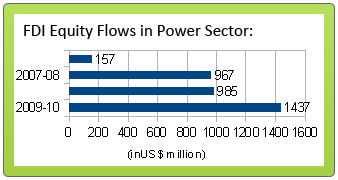 In India, 100% FDI is allowed in the Generation, Transmission and Distribution segments of the Power Sector. The FDI inflow in the Power Sector has been on the rise in the last 5 years. This trend is expected to continue in the coming years considering the huge opportunities available in the sector. FDI inflow is important for the power sector because it brings in money and India’s power sector is in huge need of investments. More importantly, FDI also brings in advanced technology making the sector more efficient. Hence, this proves to be a major growth driver for the power sector.
In India, 100% FDI is allowed in the Generation, Transmission and Distribution segments of the Power Sector. The FDI inflow in the Power Sector has been on the rise in the last 5 years. This trend is expected to continue in the coming years considering the huge opportunities available in the sector. FDI inflow is important for the power sector because it brings in money and India’s power sector is in huge need of investments. More importantly, FDI also brings in advanced technology making the sector more efficient. Hence, this proves to be a major growth driver for the power sector.
6) Growth Drivers for Power from Nuclear, Hydro and Renewable Energy Sources: –
With the thermal power generation segment facing the issue of shortages of coal (major raw material), other power generation sources like nuclear, hydro and renewable energy sources will get attention in the coming years.
Nuclear power projects account for 2.75% of India’s total installed capacity which is about 4.77 GW. The Planning Commission’s expert committee on an Integrated Energy Policy has suggested in its report that there is a possibility of reaching a nuclear power capacity of 21-29 GW by 2020 and 48-63 GW by 2030.
The hydro power segment offers investment opportunities as India is considered to have hydro power generation potential worth 1,50,000 MW; of which only 25% has been harnessed till date
Using renewable sources to generate electricity has several advantages like a perennial energy source, potential for lower reliance on imported fossil fuels and lower CO2 emissions. However, at present the major hurdle facing rapid expansion of renewable power is high initial cost as compared to the competing fuels. But taking in to consideration the environmental concerns, this segment receives encouragement from the Government. Its share in the country’s total generation capacity has increased from 1.1% in 2001-02 to 10.63% as on 31st March, 2011 and is expected to increase in the future.
These three non-thermal sources of power also offer good investment opportunities. Companies are diversifying their power portfolios to take advantage of opportunities available in hydro power and renewable energy sources.
Roadblocks (Challenges): –
Power Sector is a highly capital-intensive industry with long gestation periods, before the commencement of revenue generation. Since most of projects have a long time frame (4-5 years of construction period and operating period of over 25 years), there are some inherent risks which this sector faces.
Availability of Coal: –
Coal is the mainstay of the power production in India and is expected to remain so in the future. India has limited coal reserves, plus, availability of domestic coal is a challenge on account of various bottlenecks such as capacity expansion of Coal India Limited (the largest coal producing company in the world, coal block allocation, tribal land acquisition, environmental and forest clearances, etc.
Transportation of coal is a big concern in itself. Within the country, coal is transported by Indian Railways and in case of imports; coal is to be unloaded at ports. In both cases, India currently faces capacity shortage. Hence, a project developer has to account for and manage its logistics chain in a manner that ensures regular fuel supply which is a big challenge.
Dependence on Equipment Suppliers: –
The power sector is heavily dependent on Equipment suppliers. In fact, equipment shortages have been a significant reason for India missing its capacity addition targets for the 10th five year plan. While the shortage has been primarily in the core components of boilers, turbines and generators, there has been lack of adequate supply of Balance of Plant (BOP) equipment as well. These include coal handling, ash-handling plants, etc. Apart from these, there is shortage of construction equipment as well. Hence, inadequate supply of equipments is a cause of concern for the power companies.
Aggregate Commercial and Technical Losses: –
The Aggregate Technical and Commercial Loss (AT&C) is defined as the power lost due to inefficient transmission and distribution infrastructure. India’s AT&C losses are as high as 30% compared with 5-10% in the developed markets which means out of every 100 units produced, 30 are lost during transmission and distribution. Technical losses are due to inadequate investments over the years for system improvement works. Commercial losses are mainly due to low metering efficiency, pilferage and theft of power. This is a huge problem for the power sector.
Other Roadblocks leading to Demand Supply Gap: –
The power sector has other concerns like shortage of skilled manpower for construction and commissioning of projects, contractual disputes between project authorities, contractors and their sub-vendors, delay in readiness of balance of plants by the executing agencies. Difficulties have been experienced by developers in land acquisition, rehabilitation, environmental and forest – related issues, inter-state issues, geological surprises (particularly for Hydro projects) and contractual issues. These issues continue to pose challenges to maintain the pace of development of power projects.
Future Prospects and Conclusion:
India has stepped its development agenda and power is an inevitable element of economic growth and development. Growth in the power sector is related to India’s GDP growth rate and hence, in order to sustain the growth of 8-9% in GDP, India needs to continuously add power generation capacity to commensurate with this pace.
Although, the Indian power sector is one of the fastest growing sectors in the world and energy availability has increased by around 36% in the past 5 years, the demand for power outstrips its supply. Nearly 60 crore Indians do not have access to electricity. The energy and peaking deficits have been hovering around double digits for the past two years and the condition might worsen in the coming years considering the huge demand of power from India’s rising population and rapid industrialization and urbanization. Hence, there is no slowing down of demand for the Power Sector, thus offering ample scope for rapid capacity expansion.
The Government is investing in this industry through various development schemes like Rajeev Gandhi Rural Electrification Program, ‘Power for all by 2012’ and Accelerated Power Development and Reform Programme (ARDRP), Ultra Mega Power Projects etc. It has also been is encouraging participation of private players in this Sector.
Renewable energy sources are also being encouraged considering the growing environmental concerns. Hence, the future prospects of nuclear power, hydro power and power from renewable energy sources are also good
Looking at the above points, the long term future prospects of the Indian Power Sector appear to be Green (Very Good).
It is very important that while investing in a company, an investor selects an industry, where the long-term future prospects are bright. We have seen that in the long run the Indian Power sector is expected to have good growth.
Also, it is equally important that the company has an excellent financial track record( i.e. Green 10 Year X-Ray) and its long-term future prospects are Green (Very Good).
*The 10 YEAR X-RAY facilitates analysis of the financial performance of the company considering the five most important parameters. A 10 Year period will normally encompass an entire business cycle. Analysing the performance over this time frame is essential to understand how a company has fared during the good as well as bad times. The five most important parameters that one needs to look at are Net Sales Growth Rate, EPS Growth Rate, Book Value Per Share (BVPS) Growth Rate, Return on Invested Capital (ROIC) and Debt to Net Profit Ratio.
Given below is the MoneyWorks4me assessment for a few Power companies: At MoneyWorks4me we have assigned colour codes to the 10 YEAR X-RAY and Future Prospects of the companies, as Green (Very Good), Orange (‘Somewhat Good’) and Red (Not Good).
Competitive Scenario:
While investing, one must always invest in the stocks of a company that operates in an industry with bright long-term prospects. Further, the company’s 10 YEAR X-RAY and future prospects should also be Green. In the case of the power sector, though, it is poised for good growth in the future, it remains to be seen whether the above companies can completely take benefit of this growth and reflect it in their performance. Because of the very nature of the power sector (capital intensive+high debt), most of these companies have had muted growth in one or more of their parameters. Hence, investors with some appetite for risk can consider investing in these companies, but only at the right price. (i.e. when the market offers an attractive discount). To find out the right price to invest in these companies, become a member of MoneyWorks4me.com.
Disclaimer: This publication has been prepared solely for information purpose and does not constitute a solicitation to any person to buy or sell a security. It does not constitute a personal recommendation or take into account the particular investment objectives, financial situations or needs of an individual client or a corporate/s or any entity/ies. The person should use his/her own judgment while taking investment decisions.
If you liked what you read and would like to put it in to practice Register at MoneyWorks4me.com. You will get amazing FREE features that will enable you to invest in Stocks and Mutual Funds the right way.
Need help on Investing? And more….Puchho Befikar
Kyunki yeh paise ka mamala hai
Start Chat | Request a Callback | Call 020 6725 8333 | WhatsApp 8055769463


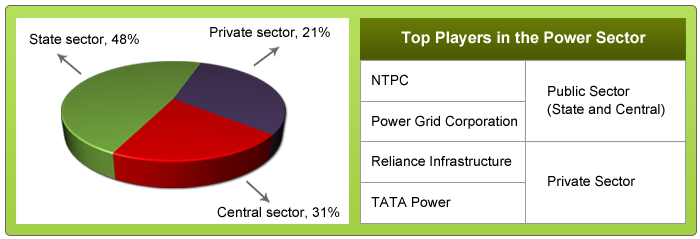
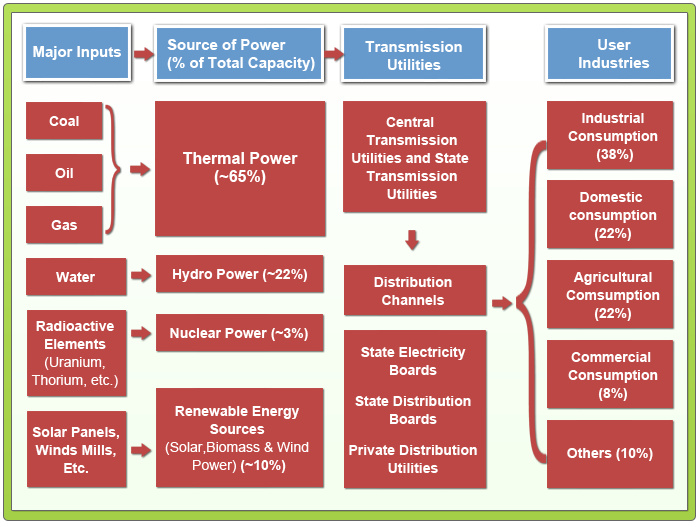
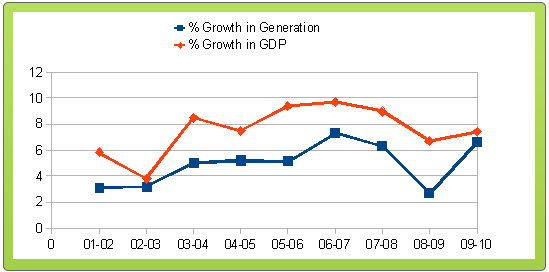
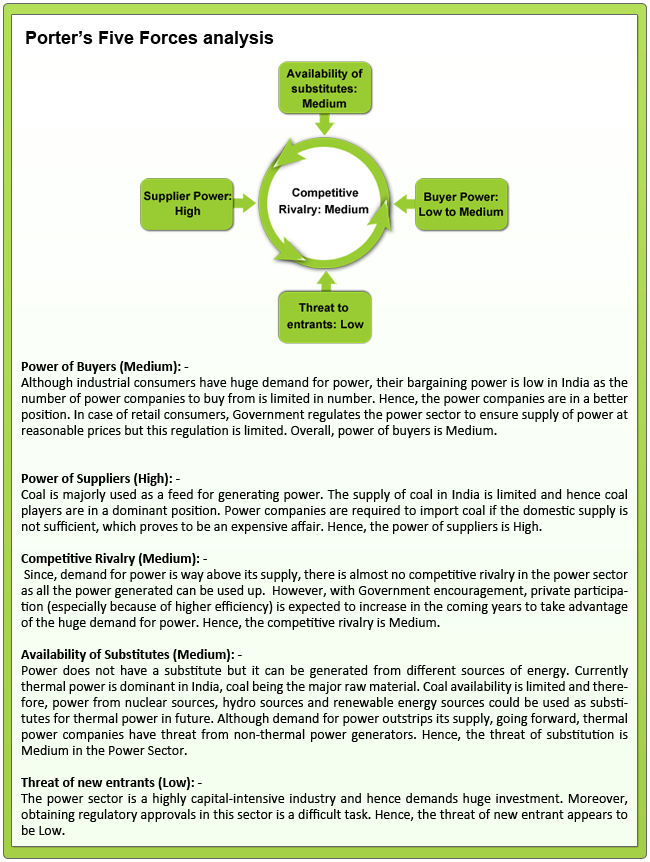
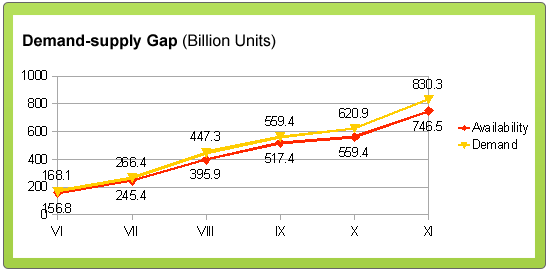
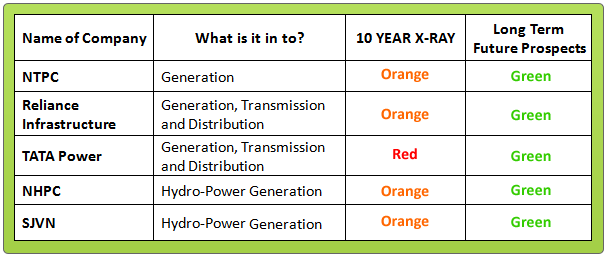


very nice article have extensive data of power demand and production
Good brief and comprehensive / efficiant analysis.
—-Amar-shettar M.M. (retired) Chief Manager, State Bank of India,
Mob: 94484 67585 and Mob-98446 64226
Excellent analysis. However, would have been more useful if the reasons for colour coding were also explained.
@1fb1f16b6d9123c94dec38f240d535a8:disqus – The MoneyWorks4me 10 YEAR X-RAY is based on 5 critcial parameters and has a simple color-coding assigned to the Financial Track record where Green means Very Good, Orange – ‘Somewhat Good’, and Red – Not Good. For more on the parameters and the benchmarks used for colour coding, please do read the help section of MoneyWorks4me.com. Here’s the link for the same – http://bit.ly/maloSJ
analysis of power is great but i confuse about to suzlon energy when govt. is forcing on renewable energy section then why it,s future is orange, and 10 yr. exray the TATA Power is more efficient run then R. Power and engaged in thermal as well as solar with BP and try to enter nuclear and all source of renewable energy are showing red, and the vital point i feel the study has missed the power transportation study, can any one claryfy me
Hi,
Yes, with the Government’s focus on encouraging usage of renewable sources of energy in future, the wind power industry is expected to grow with phenomenal rate of more than 20% in the next 5 years. With its strong brand and vast infrastructure and geographical reach, Suzlon Energy is well poised to garner the full advantage of this growth opportunity. But, looking at its high debt position and Europe’s economic recession we expect the long-term future prospects of Suzlon Energy to be Orange (‘Somewhat Good’).
Also, the MoneyWorks4me assessment for Tata Power’s 10 YEAR X-RAY is Red i.e Not Good. At MoneyWorks4me.com while giving our assessment of the 10 YEAR X-RAY, we analyse its financial track record over a 10 Year period. In the case of Tata Power (standalone financial track record), the Company has performed well after FY2006, however, the growth rates have been quite erratic. Over the past 9 years, the Sales and EPS of the company have grown only by ~6% and ~10% respectively(unaudited FY11). ROIC figures over the last 6 years are not impressive; and a high Debt to Net Profit ratio is a cause of concern for the Company. Considering the high Debt to Net Profit ratio and the volatile growth rates, the standalone 10 YEAR X-RAY of the Company has been rated as RED (Not Good).
As far as the power transportation study is concerned, we have covered it as one of the points in growth drivers as the power sector is dependant on this point. We will be covering it further in the power (transmission equipment) sector.
The 10 year X – Ray conducted by moneyworks4me.com for TATA POWER LTD shows RED.Why is it so?TATA POWER is one private sector company(apart from Reliance Energy) which has given consistent performance all through the years.Any reason for showing it in RED?
At MoneyWorks4me.com while giving our assessment of the 10 YEAR X-RAY, we analyse its financial track record over a 10 Year period. In the case of Tata Power (standalone financial track record), the Company has performed well after FY2006, however, the growth rates have been quite erratic. Over the past 9 years, the Sales and EPS of the company have grown only by ~6% and ~10% respectively(unaudited FY11). ROIC figures over the last 6 years are not impressive; and a high Debt to Net Profit ratio is a cause of concern for the Company. Considering the high Debt to Net Profit ratio and the volatile growth rates, the standalone 10 YEAR X-RAY of the Company has been rated as RED (Not Good).
The simplicity yet detailed approach is what makes your report such a hit. Kudos. If possible would request you to come out with a report on ‘Oil & Gas’ sector. Also it will be nice if you can mention about a few small & mid tier companies and let us know as to which sub-sector of the industry they fall into. Cheers – Vishal
Hi Vishal,
Thanks a lot for your appreciation. It is our constant endeavor to keep our analysis simple, detailed and yet interesting. In our current series of Stock Shastra we are covering all the major sectors/industries; soon we will be coming up with our analysis on Oil and Gas. And yes, we will certainly consider your suggestion about including the details about small and mid-tier companies. Do keep reading and let us know how you find our articles.
No doubt POWER sector has tremounds growth.But waiting period is also so long
that one has to have courage to hold for suchalong.
Mziom, Amar-shettar, Duvvuryseshu – We are glad that you liked our analysis on the Power Sector. Stay updated on this space for more analysis reports on various other important sectors.
@1fb1f16b6d9123c94dec38f240d535a8:disqus – The MoneyWorks4me 10 YEAR X-RAY is based on 5 critcial parameters and has a simple color-coding assigned to the Financial Track record where Green means Very Good, Orange – ‘Somewhat Good’, and Red – Not Good. For more on the parameters and the benchmarks used for colour coding, please log onto MoneyWork4me.com.
hi!!
it just so useful material…i think is so good it helps me in my project as i can analyse it like with economic views..m really appreciate for this critical analysis…its really wonderful…
Hi,
We are glad that you have found our analysis on the power sector helpful. Stay updated on this space for more analysis reports on various other important sectors.Thanks a lot for the appreciation.
Thanks for providing well researched material in a simple manner. M K CHOPRA,DELHI
thanks for brief authentic info…..:)
Good summary of such a complex sector
Very valuable inputs for new entrants. Vast research put forward in simple and illustrative presentation. And big thanks.
thank you
I read this years ago and loved it. I should take it out again. I read a beautiful JF book not long ago I’ve been meaning to blog about but just ha&tnv#8217;e. It’s called The Tale of the Swamp Rat. I just picked it up on a whim. I can’t say it’s gripping in the same sense a Harry Potter is, but it’s so well crafted and so beautifully written it was an absolute pleasure to read. The author is Carter Croker. You might enjoy it. It’s a verbal work of art.
Hello Sir,
Can I got an update on Torrent Power Limited performance viz the 10 year x ray result, since the company is having monopolistic market in gujarat.
regards,
Deep Chowdhury
wonderful publish, very informative. I wonder why the other specialists of this sector
don’t understand this. You should proceed
your writing. I’m confident, you have a huge readers’
base already!
I am truly thankful to the owner of this web site who
has shared this great article at at this time.
It’s an amazing post for all the web viewers; they will take advantage from it I am sure.
I was excited to find this web site. I want to to thank you for your time
just for this fantastic read!! I definitely appreciated
every little bit of it and I have you book-marked to see new information on your site.
I am no longer certain the place you are getting your information, but great topic.
I needs to spend a while learning more or working out more.
Thanks for great info I was searching for this information for my mission.
Appreciate this post. Let me try it out.
Hello! I could have sworn I’ve visited this site before but
after going through many of the articles I realized it’s new to me.
Nonetheless, I’m certainly pleased I came across it and I’ll
be book-marking it and checking back frequently!